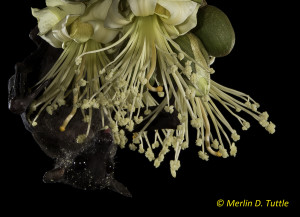
The story of Cave Nectar Bats’ contributions and requirements is complex and only beginning to be fully understood. These bats traditionally formed huge colonies in caves, 100,000 individuals in a single cave. However colonies are extremely vulnerable, and few large colonies remain. People commonly set nets over cave entrances, capturing large numbers to be eaten as a delicacy. Also, limestone quarries pose constant threats of permanent destruction of essential caves, and durian growers themselves sometimes kill large numbers.
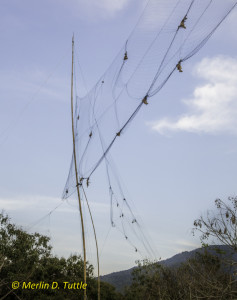
Recently, while driving to a durian orchard to interview a well-informed grower, Bang Maad, near the town of Khao Phra in southern Thailand, we spotted 40-foot-long mist nets stretching for as far as we could see through a longan orchard, each net sagging under the weight of dead and dying bats that are needed to pollinate adjacent durian orchards. In just the first two nets, we counted 32 bats. Sara explained that the nets are cheap here, costing just 3 U.S. dollars each. Especially in longon orchards, they are simply left up till they fall from the weight of dead bats. He estimates there are some 20 longan farmers in this one area who are most of them setting such nets to kill bats.
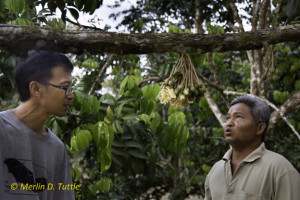
The bats are coming from a cave that is protected in the nearby Ton-NGA-Chang Wildlife Sanctuary. However, once the bats leave to feed they are no longer protected, and the numbers now being killed in adjacent longan orchards likely cannot be sustained for long. Between Sara and Bang Maad I learned that longan fruit orchards have only relatively recently been introduced. This is not a fruit that is native to the area, and to succeed it requires heavy pesticide and fertilizer applications as well as extra irrigation. Durians, which are native, are now being harmed by the longan growers who kill bats. Bang reports that durian pollination is declining, and he believes the problem is a result of too many farmers killing too many bats. He laments that even some durian growers kill bats, mistakenly believing they harm crops when they see petals and anthers falling from just pollinated flowers. He has grown durian here for more than 30 years and is deeply concerned about declining pollination success.
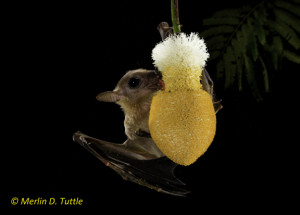
There are alternatives for protection of longan and other fruits attractive to bats. Recent research in Australia is confirming long-time reports of an ideal solution–bird netting. This heavy-duty material is harmless to wildlife and aids fruit growers by protecting fruit from birds, bats and hail storms. It also greatly reduces irrigation needs, and facilitates earlier crop ripening, leading to better prices. In most cases, just a little friendly education and perhaps low interest loans from governments, could greatly improve the future for humans.
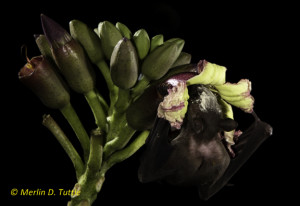
Finally, both pollinating and insect-eating bats needed to protect crops greatly benefit from programs to protect biodiversity, providing easily understood arguments for expanded conservation. Durians bloom for only a few weeks per year, meaning their pollinators must have alternative food sources to tide them over between cycles. Cave Nectar Bats are primary pollinators for a wide variety of SE Asia’s most economically valuable plants, including many wild banana and durian species, as well as petai and Indian trumpet flowers. Additionally, mangroves are pollinated by these and several other species of bats, and are ecologically vital to production of sea foods.
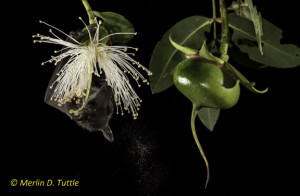
The plight of pollinators such as the Cave Nectar Bat cannot be ignored without potentially serious problems for humans. That’s why we’ve been working so hard to photographically tell their story before it is too late to save these key allies. We hope you’ll enjoy seeing them in action. We plan to make these new photographs broadly available through this web site within a few weeks and express our deepest appreciation to Jeff and Helen Acopian, Daniel and Heidi Hargreaves, Dudley and Mari Houghton and Scott and Hella McVay for their crucial support. Jeff Acopian also provided invaluable volunteer assistance throughout this work.
